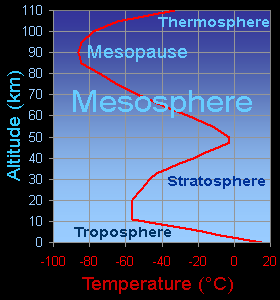As you go higher in the mesosphere, the air gets colder.
Click on image for full size
Original artwork by Windows to the Universe staff (Randy Russell).
Temperature in the Mesosphere
The top of the mesosphere is the coldest part of the atmosphere. It can get down to -90° C (-130° F) there! As you go higher in the mesosphere, the air gets colder.
The air is much thinner (less dense) in the mesosphere than in the stratosphere below. There are fewer air molecules to absorb incoming electromagnetic radiation from the Sun. That includes molecules of ozone, which absorb ultraviolet radiation and heat the stratosphere. In the mesosphere, the thin air and small amounts of ozone prevent the air from warming much.
Carbon dioxide in the mesosphere also helps make this layer cold. CO2 molecules absorb heat energy when they bounce off of other molecules. The CO2 releases some of that energy as photons in a process called radiative emission. Some of those photons travel upward into space. This carries heat away from the mesosphere.
You might also be interested in:

Electromagnetic radiation is the result of oscillating electric and magnetic fields. The wave of energy generated by such vibrations moves through space at the speed of light. And well it should... for
...more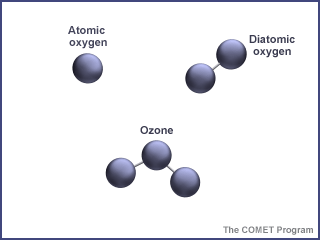
Ozone is a special kind of oxygen molecule. Normal oxygen molecules (O2), the kind we need to breathe, have two oxygen atoms. Ozone molecules (O3) have three oxygen atoms. Ozone forms when a photon of
...more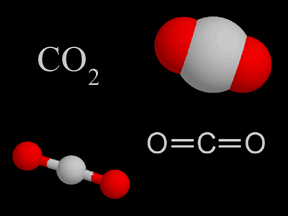
Carbon dioxide (CO2) is a kind of gas. There isn't that much carbon dioxide in Earth's atmosphere, but it is still very important. Carbon dioxide is a greenhouse gas. That means it helps trap heat coming
...more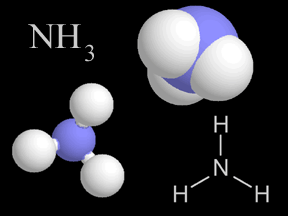
Most things around us are made of groups of atoms bonded together into packages called molecules. The atoms in a molecule are held together because they share or exchange electrons. Molecules are made
...more
Rainbows appear in the sky when there is bright sunlight and rain. Sunlight is known as visible or white light and is actually a mixture of colors. Rainbows result from the refraction and reflection of
...more
The Earth travels around the sun one full time per year. During this year, the seasons change depending on the amount of sunlight reaching the surface and the Earth's tilt as it revolves around the sun.
...more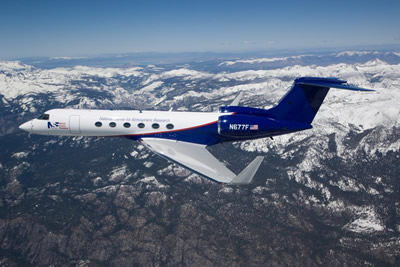
Scientists sometimes travel in specially outfitted airplanes in order to gather data about atmospheric conditions. These research aircraft have special inlet ports that bring air from the outside into
...more


